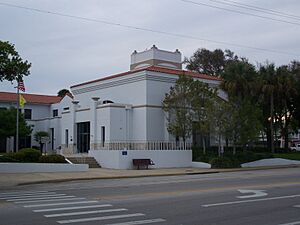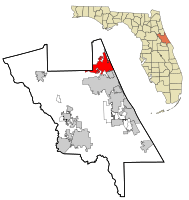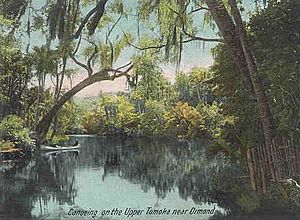Ormond Beach, Florida facts for kids
Quick facts for kids
Ormond Beach, Florida
|
|
|---|---|

Ormond Beach City Hall
|
|
| Nickname(s):
Birthplace of Speed
|
|

Location in Volusia County and the state of Florida
|
|
| Country | |
| State | |
| County | Volusia |
| Settled by Native Timucuans (Nocoroco) | c. early 1500s |
| Settled by American colonizers (New Britain) |
c. 1860s-1870s |
| Incorporated (Town of Ormond) |
April 22, 1880 |
| Incorporated (City of Ormond Beach) |
April 25, 1950 |
| Government | |
| • Type | Commission-Manager |
| Area | |
| • City | 38.91 sq mi (100.78 km2) |
| • Land | 34.78 sq mi (90.09 km2) |
| • Water | 4.13 sq mi (10.69 km2) |
| Elevation | 7 ft (2 m) |
| Population
(2020)
|
|
| • City | 43,080 |
| • Density | 1,238.50/sq mi (478.18/km2) |
| • Urban | 349,064 (109th U.S.) |
| • Metro | 609,939 (90th U.S.) |
| Time zone | UTC−05:00 (Eastern (EST)) |
| • Summer (DST) | UTC−04:00 (EDT) |
| ZIP Codes |
32174-32176
|
| Area code(s) | 386 |
| FIPS code | 12-53150 |
| GNIS feature ID | 0307388 |
Ormond Beach is a city in Volusia County, Florida, United States. It is located just north of Daytona Beach. In 2020, about 43,080 people lived there.
Ormond Beach is famous as the "Birthplace of Speed." This is because early car enthusiasts loved to race their new cars on its hard, flat beaches. Back then, there weren't many paved roads, so the beach was the perfect place to test how fast cars could go! The city is in the central eastern part of Florida.
Contents
History of Ormond Beach
Early Settlements
Long ago, around the early 1500s, a Timucuan town called Nocoroco was located near where the Tomoka River meets the Halifax River. This is just north of where Ormond Beach is today. A Spanish explorer named Álvaro Mexía visited the area in 1605. He was trying to make friends between the Spanish and local tribes. We don't know much about what happened to the people living there after his visit.
The city gets its name from James Ormond I. He was a sea captain who helped the King of Spain. Later, in 1821, the United States bought Florida from Spain. However, fighting during the Second Seminole War stopped people from settling there until after 1842. In 1875, a group from New Britain, Connecticut, started a community called New Britain. But on April 22, 1880, it became the Town of Ormond, named after the early plantation owner.
Becoming a Tourist Spot
Ormond Beach became a popular place for wealthy people to visit. They wanted to escape the cold northern winters. This happened after the Civil War when tourism in Florida grew. A railway arrived in 1886, making it easier to get there. The first bridge across the Halifax River was built in 1887.
The famous Ormond Hotel opened its doors on January 1, 1888. Henry Flagler, a very rich businessman, bought the hotel in 1890. He made it much bigger to hold 600 guests. This hotel was part of a chain of fancy hotels for people traveling on his Florida East Coast Railway. The Ormond Hotel was a well-known landmark. Sadly, it was torn down in 1992.
One of Flagler's friends, John D. Rockefeller, who was also a very rich businessman, stayed at the Ormond Hotel. He loved it so much that he bought a home nearby called The Casements in 1914. This became his winter home for many years. Today, The Casements is a cultural center for the community. It's the most famous historical building in Ormond Beach.
The Birthplace of Speed
Starting in 1902, some of the very first automobile races took place on the hard sand beaches. These races went from Ormond south to Daytona Beach. Car pioneers like Ransom Olds (who made Oldsmobiles) and Alexander Winton tested their new inventions here.
In 1903, the American Automobile Association (AAA) started timing the races. This is how the area got its nickname, "The Birthplace of Speed." In 1907, Glenn Curtiss even set a world record on his powerful motorcycle, going 136.36 miles per hour! Even today, you can still drive cars on some parts of the beach.
The town was officially renamed the City of Ormond Beach on April 25, 1950.
Ormond Beach has four parks along the river and one park on the beach. There are also 37 other parks and gardens. The historic shopping area on Granada Boulevard has many local shops and restaurants. It also has historical and cultural sites.
Geography

Ormond Beach is located at about 29.286405 degrees North and -81.074882 degrees West.
The city covers a total area of about 39 square miles (101 square kilometers). Most of this is land (about 32 square miles or 82.7 square kilometers), and the rest is water (about 7 square miles or 18.3 square kilometers). The Tomoka River flows through the area. Ormond Beach is also located on the Halifax River lagoon and borders the Atlantic Ocean.
Climate
The weather in Ormond Beach has hot and humid summers. The winters are usually mild. This type of weather is called a humid subtropical climate.
Population Changes
| Historical population | |||
|---|---|---|---|
| Census | Pop. | %± | |
| 1890 | 239 | — | |
| 1900 | 595 | 149.0% | |
| 1910 | 780 | 31.1% | |
| 1920 | 1,292 | 65.6% | |
| 1930 | 1,517 | 17.4% | |
| 1940 | 1,914 | 26.2% | |
| 1950 | 3,418 | 78.6% | |
| 1960 | 8,658 | 153.3% | |
| 1970 | 14,063 | 62.4% | |
| 1980 | 21,436 | 52.4% | |
| 1990 | 29,721 | 38.6% | |
| 2000 | 36,301 | 22.1% | |
| 2010 | 38,137 | 5.1% | |
| 2020 | 43,080 | 13.0% | |
| U.S. Decennial Census | |||
The population of Ormond Beach has grown a lot over the years. In 1890, only 239 people lived there. By 2020, the population had grown to 43,080 people.
Population Details (2010 and 2020)
| Race | Pop 2010 | Pop 2020 | % 2010 | % 2020 |
|---|---|---|---|---|
| White (NH) | 33,920 | 35,455 | 88.94% | 82.30% |
| Black or African American (NH) | 1,196 | 1,669 | 3.14% | 3.87% |
| Native American or Alaska Native (NH) | 56 | 76 | 0.15% | 0.18% |
| Asian (NH) | 856 | 1,305 | 2.24% | 3.03% |
| Pacific Islander or Native Hawaiian (NH) | 13 | 13 | 0.03% | 0.03% |
| Some other race (NH) | 55 | 146 | 0.14% | 0.34% |
| Two or more races/Multiracial (NH) | 462 | 1,567 | 1.21% | 3.64% |
| Hispanic or Latino (any race) | 1,579 | 2,849 | 4.14% | 6.61% |
| Total | 38,137 | 43,080 |
In 2020, there were 43,080 people living in Ormond Beach. These people made up 18,554 households and 11,121 families.
Famous People from Ormond Beach
Many interesting people have connections to Ormond Beach, including:
- Paul America, an actor
- Adelbert Ames, a general from the Civil War
- Lisa Andersen, a professional surfer
- Ben Brainard, a comedian and social media star
- Shirley Chisholm, a U.S. Congress member and presidential candidate
- David Allan Coe, a musician
- Phil Dalhausser, an Olympic gold medalist in beach volleyball
- Jacob deGrom, an MLB pitcher for the Texas Rangers
- Alan Gustafson, a NASCAR crew chief
- Brian Kelley, a musician from Florida Georgia Line
- Paul LePage, a politician
- John D. Rockefeller, a famous billionaire businessman
- Freelan Oscar Stanley and Francis Edgar Stanley, who started the Stanley Motor Carriage Company (known for Stanley Steamers)
- Corey Walden, a professional basketball player
- Harry Wendelstedt, a baseball umpire
Fun Places to Visit
Ormond Beach has several interesting places to explore:
- Anderson-Price Memorial Library Building
- The Casements (John D. Rockefeller's former winter home)
- Dix House
- Bulow Creek State Park
- Ormond Memorial Art Museum and Gardens
- North Peninsula State Park
- Tomoka State Park
Getting Around Ormond Beach
Airports
The main airport in Ormond Beach is the Ormond Beach Municipal Airport. If you need to travel internationally, you would go to the Daytona Beach International Airport.
Main Roads
Several important roads run through Ormond Beach:
- Interstate 95 (I-95) is a major highway that goes north and south along the east coast of Florida.
- US 1 (also called Ridgewood Avenue) is another main road that runs north and south through the city. It was the main highway before I-95 was built.
- Florida State Road A1A (North Atlantic Avenue) is a beautiful coastal road.
- Florida State Road 40 (Granada Boulevard) is a key road in the city.
Railroads
The main railroad line in Ormond Beach is the Florida East Coast Railway. There used to be a train station in the city that connected to the old Ormond Hotel. Passenger train service stopped in 1963. Now, only freight trains use the railway, and they don't stop in Ormond Beach.
News and Radio
Newspapers
You can read about local news in Ormond Beach through several newspapers:
- Daytona Beach News-Journal: A daily newspaper that covers the larger Daytona Beach area.
- Hometown News: A community newspaper published weekly in print and daily online.
- The Ormond Beach Observer: A weekly newspaper published in print and daily online.
- Ormond Local Pulse: A daily email newsletter focusing on local news for Ormond Beach.
Radio Stations
Ormond Beach also has local radio stations:
- WELE, 1380 AM, plays news and talk shows.
- WAVX-LP, 107.1 FM, plays contemporary Christian music.
- WHOG-FM, 95.7 FM, plays classic rock music.
What Powers Ormond Beach?
Businesses and Jobs
Ormond Beach has a busy business area. Many companies here sell their products all over the world. The Ormond Beach Business Park and Airpark is a special area for businesses. It is home to many companies that create jobs.
The city has a skilled workforce. There are seven colleges and universities nearby that help train people for jobs and support businesses. The biggest job areas in Ormond Beach are education, healthcare, and government.
Some of the companies located in Ormond Beach include:
- Costa Del Mar Headquarters (makes eye care products)
- Florida Production Engineering (makes car parts)
- Hawaiian Tropic - Tanning Research Laboratories (makes skin care products)
- ABB Thomas & Betts/Homac (makes electrical connectors)
- Hudson Technologies (a manufacturer)
- Microflex Inc.
- U.S. Food Service (a food distributor)
- Vital Aire (a healthcare company)
Shopping Spots
There are many places to shop in Ormond Beach:
- Historic Ormond Beach/Granada Blvd.
- Ormond Mall
- Ormond Town Square
- River Gate Shopping Center
- South Forty Shopping Center
- The Trails Shopping Center
- Wal-Mart Super Center
- Tanger Outlets
- Granada Plaza
Images for kids
See also
 In Spanish: Ormond Beach para niños
In Spanish: Ormond Beach para niños





